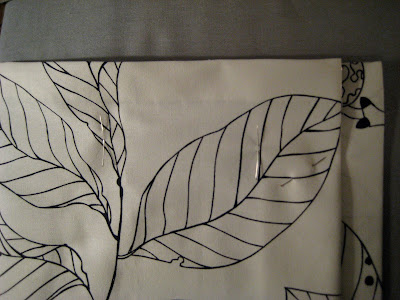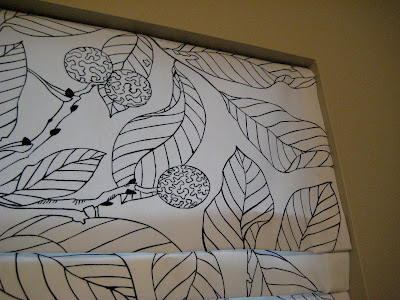I meant to finish sharing how I put my laundry room together but life just kind of got in the way. We do have the Olympics happening here and it is just plain distracting. Who can resist watching the television when hockey is on? People need to understand that the love of hockey runs in most Canadians' blood. If you read my post about the real use of my living room you'd understand.
Tonight is the BIG night.
It is Canada vs. USA for GOLD. Being Canadian I am hoping we win but I do have a soft spot for Americans because I loved living in US, shhh....don't tell anyone here though - my windows might get egged!
Tonight is the BIG night.
It is Canada vs. USA for GOLD. Being Canadian I am hoping we win but I do have a soft spot for Americans because I loved living in US, shhh....don't tell anyone here though - my windows might get egged!
I love the look of Roman blinds but didn't need one for the laundry room as the window is frosted and privacy is not an issue. I felt the window was plain and it needed something. After the quickest trip to Ikea ever I came back with the ideal fabric, a thick drapery weight cotton with a wonderful black and white graphic print. I made an ironing board cover with the fabric also, you can read about it here.
What you need:
*meter stick (yard stick)
*L-shape ruler (helps to have one to make square corners)
*fabric
*thread
*lining (if you want - I didn't use any)
*balsa wood stick, preferably flat to mount your blind
*staple gun
*nails
*hammer
*My wonderful sister directed my attention to this tutorial, how to fake a roman blind, at Sunset magazine, a great magazine that focusses on the west coast. Check it out.
The first thing that needs to be decided before you start is whether you want the blind to mount outside your window frame or inside. I chose the inside route. I measured the inside of the window frame and decided how long I wanted the blind to hang. Then I had to decide how many pleats I wanted in my faux blind. I chose to have 3.
When cutting out your fabric you need to allow for 2 inches extra along the sides and top for a hem. You then need to allow for the length to include your pleats and the bottom hem. The bottom hem should be about 2 inches, then allow for 2 inches per pleat. I allowed for the pleat to be inch wide and since you need to fold the fabric under you will need 2 inches for each 1 inch pleat.
(Are you still following me, or is this clear as mud?)
Since I wanted 3 pleats, that was 6 inches (2 x 3) + 2 inches for the bottom hem + 2 inches for the top hem + desired finished length= total length of fabric. (You must be thinking - that you would never use math again - little do you know that sewing involves math, especially drapery!)
Using a slip stitch hem all the edges, being careful to make neat corners.
After hemming all the edges you need to decide where you want to pleats to start and finish. I just played around, using pins as markers, until I achieved the look I wanted.
The next step is to tack the pleats down every few inches. To make a crisp looking blind I ironed my pleats. You don't need to, it all depends on how you want your blind to look.
Measure the width of the blind and cut your balsa wood to fit the width. Taking your staple gun, staple the inside of the top hem to the strip of wood.
Next step is to mount the strip of wood to the top of the window frame using small nails. Just nail through the wood and fabric. Balsa wood is very light and easy to nail through.
Then you can step back and admire a job well done.
After mounting my first attempt I realized the blind was a bit plain and need a bit more pop, so I untacked the pleats and added 2 rows of black grosgrain ribbon on both edges.
Ahh... much better
I am hoping to get my act together and share how I made the window chalkboard. I am also trying to write a few posts that I can share while I am off suntanning, er, working in Hawaii.
Have a wonderful Sunday and may the best Canadian man win!
Linking to:
SNS at Funky Junk Interiors
Make it Monday at Cottage Instincts
DIY Day at A Soft Place to Land
(Are you still following me, or is this clear as mud?)
Since I wanted 3 pleats, that was 6 inches (2 x 3) + 2 inches for the bottom hem + 2 inches for the top hem + desired finished length= total length of fabric. (You must be thinking - that you would never use math again - little do you know that sewing involves math, especially drapery!)
Using a slip stitch hem all the edges, being careful to make neat corners.
The next step is to tack the pleats down every few inches. To make a crisp looking blind I ironed my pleats. You don't need to, it all depends on how you want your blind to look.
Measure the width of the blind and cut your balsa wood to fit the width. Taking your staple gun, staple the inside of the top hem to the strip of wood.
Next step is to mount the strip of wood to the top of the window frame using small nails. Just nail through the wood and fabric. Balsa wood is very light and easy to nail through.
Then you can step back and admire a job well done.
After mounting my first attempt I realized the blind was a bit plain and need a bit more pop, so I untacked the pleats and added 2 rows of black grosgrain ribbon on both edges.
Ahh... much better
I am hoping to get my act together and share how I made the window chalkboard. I am also trying to write a few posts that I can share while I am off suntanning, er, working in Hawaii.
Have a wonderful Sunday and may the best Canadian man win!
Linking to:
SNS at Funky Junk Interiors
Make it Monday at Cottage Instincts
DIY Day at A Soft Place to Land











